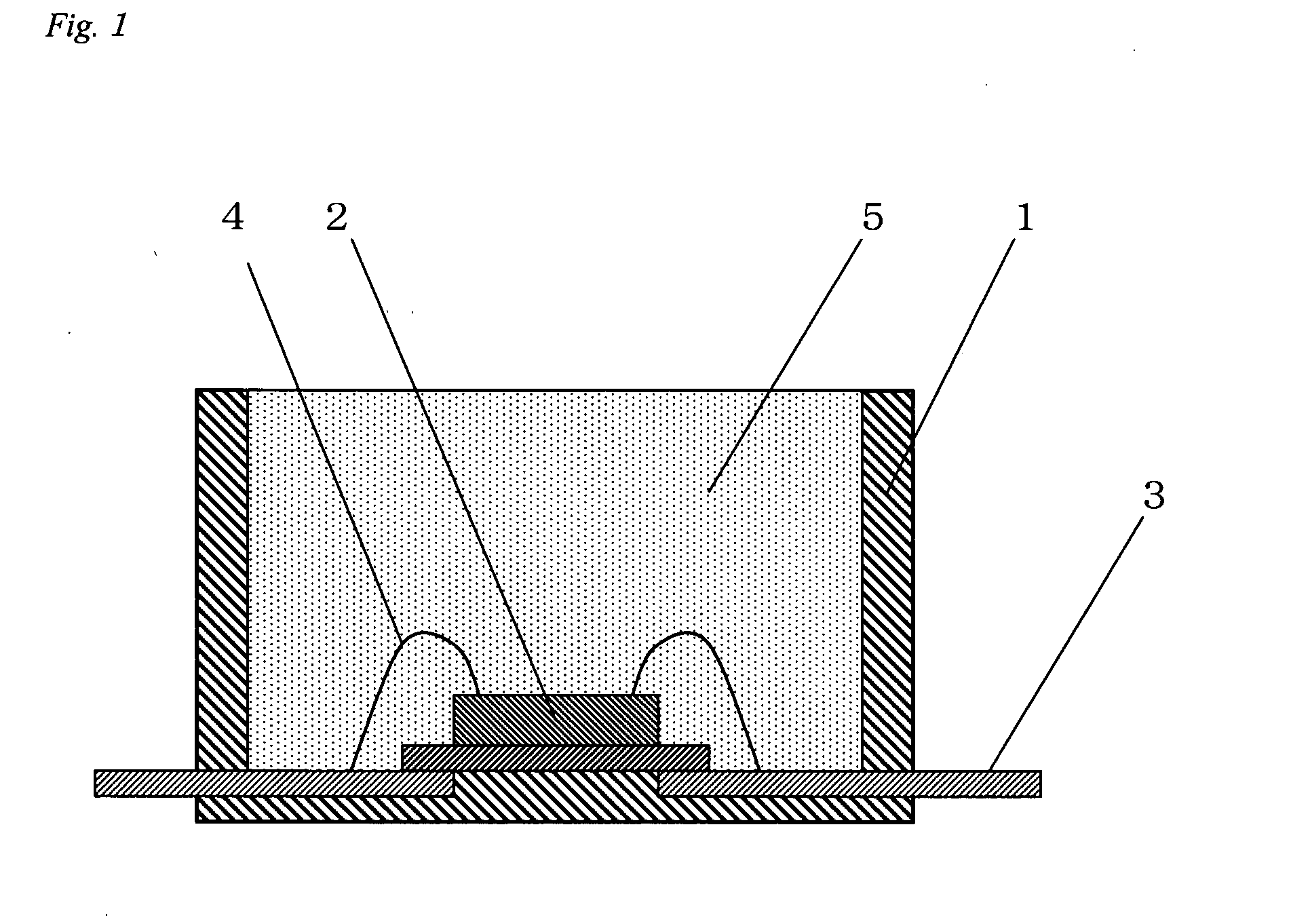Curable Organopolysiloxane Composition and Semiconductor Device
- Summary
- Abstract
- Description
- Claims
- Application Information
AI Technical Summary
Benefits of technology
Problems solved by technology
Method used
Image
Examples
example 1
Practical Example 1
[0049]A curable organopolysiloxane composition having viscosity of 3,400 mPa·s was prepared by uniformly mixing the following components:
[0050]60 parts by mass of a methylphenylpolysiloxane capped at both molecular terminals with dimethylvinylsiloxy groups (viscosity=3,500 mPa·s; vinyl group content=1.5 mass %; content of phenyl groups in all silicon-bonded organic groups=49 mole %);
[0051]20 parts by mass of a branched-chain organopolysiloxane which is solid at 25° C. and is represented by the following average unit formula:
(PhSiO3 / 2)0.75(ViMe2SiO1 / 2)0.25
(content of vinyl groups=5.6 mass %; content of phenyl groups in all silicon-bonded organic groups=50 mole %);
[0052]10 parts by mass of a diphenylpolysiloxane represented by the following formula:
HMe2SiO(Ph2SiO)2SiMe2H
(viscosity=115 mPa·s; content of silicon-bonded hydrogen atoms=0.32 mass %; content of phenyl groups in all silicon-bonded organic groups=50 mole %);
[0053]10 parts by mass of a branched-chain organo...
example 2
Practical Example 2
[0058]A curable organopolysiloxane composition having viscosity of 2,100 mPa·s was prepared by uniformly mixing the following components:
[0059]70 parts by mass of a branched-chain organopolysiloxane which was solid at 25° C. and is represented by the following average unit formula:
(PhSiO3 / 2)0.75(ViMe2SiO1 / 2)0.25
(content of vinyl groups=5.6 mass %; content of phenyl groups in all silicon-bonded organic groups=50 mole %);
[0060]30 parts by mass of a diphenylpolysiloxane represented by the following formula:
HMe2SiO(Ph2SiO)SiMe2H
(viscosity=115 mPa·s; content of silicon-bonded hydrogen atoms=0.60 mass %; content of phenyl groups in all silicon-bonded organic groups=33 mole %);
[0061]2 parts by mass of a branched-chain organopolysiloxane represented by the following average unit formula:
(PhSiO3 / 2)0.60(EpMeSiO2 / 2)0.20(ViMe2SiO1 / 2)0.20
(viscosity=37,000 mPa·s; content of vinyl groups in all silicon-bonded organic groups=12.5 mole %; content of 3-glycidoxypropyl groups in a...
example 3
Practical Example 3
[0065]A curable organopolysiloxane composition having viscosity of 2,400 mPa·s was prepared by uniformly mixing the following components:
[0066]40 parts by mass of a methylphenylpolysiloxane capped at both molecular terminals with dimethylvinylsiloxy groups (viscosity=3,500 mPa·s; content of vinyl groups=1.5 mass %; content of phenyl groups in all silicon-bonded organic groups=49 mole %);
[0067]40 parts by mass of a branched-chain organopolysiloxane which is solid at 25° C. and is represented by the following average unit formula:
(PhSiO3 / 2)0.75(ViMe2SiO1 / 2)0.25
(content of vinyl groups=5.6 mass %; content of phenyl groups in all silicon-bonded organic groups=50 mole %);
[0068]20 parts by mass of a diphenylpolysiloxane represented by the following formula:
HMe2SiO(Ph2SiO)SiMe2H
(viscosity=5 mPa·s; content of silicon-bonded hydrogen atoms=0.60 mass %; content of phenyl groups in all silicon-bonded organic groups=33 mole %);
[0069]4 parts by mass of a branched-chain organo...
PUM
| Property | Measurement | Unit |
|---|---|---|
| Temperature | aaaaa | aaaaa |
| Fraction | aaaaa | aaaaa |
| Fraction | aaaaa | aaaaa |
Abstract
Description
Claims
Application Information
 Login to View More
Login to View More - R&D
- Intellectual Property
- Life Sciences
- Materials
- Tech Scout
- Unparalleled Data Quality
- Higher Quality Content
- 60% Fewer Hallucinations
Browse by: Latest US Patents, China's latest patents, Technical Efficacy Thesaurus, Application Domain, Technology Topic, Popular Technical Reports.
© 2025 PatSnap. All rights reserved.Legal|Privacy policy|Modern Slavery Act Transparency Statement|Sitemap|About US| Contact US: help@patsnap.com


